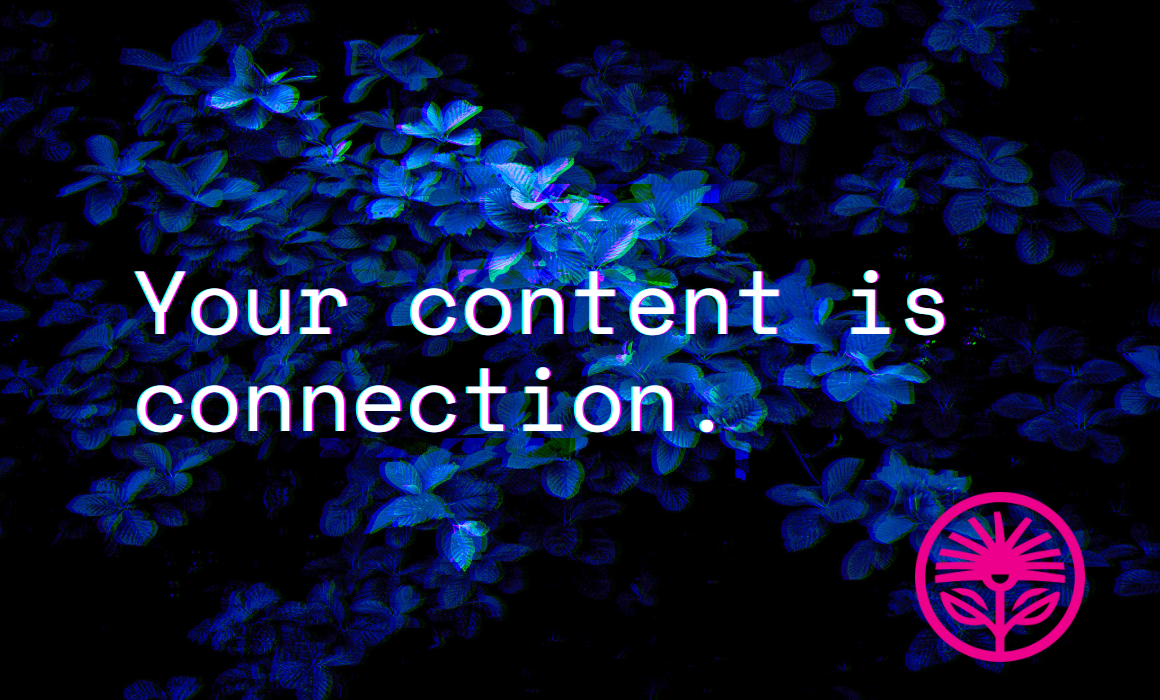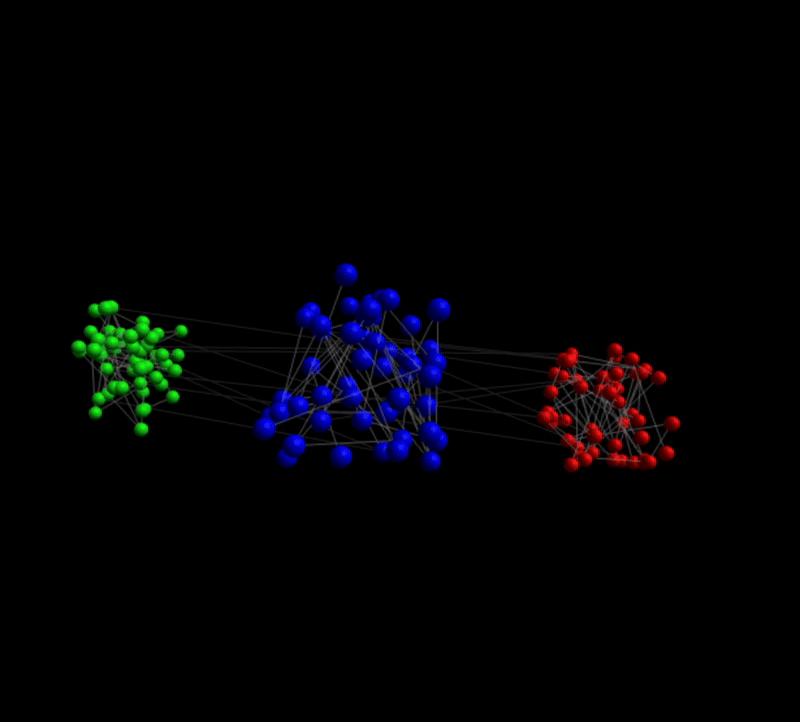Your content is connection — Kelford Labs Weekly
A new model for marketing content.

“We now inhabit a world where most of the information that has ever existed is less than ten years old. From the beginnings of human civilization until 2003, five exabytes of data were created. We are now creating five exabytes of data every two days.”
— Amy Webb, The Signals Are Talking
Marketing needs a new model for content.
One not about generation, but about connection.
Because here’s the problem: It doesn’t take any skill, knowledge, or intelligence to create “content” anymore.
When I create a new newsletter or LinkedIn post, its existence alone does not constitute value.
When any entrepreneur or marketer makes a message, nothing valuable has been created or gained simply by the act of generation.
It is now possible, thanks to LLMs and AI, to create content that has no intrinsic value whatsoever.
And some have chosen to fight fire with fire. To say, “Everyone’s making content with AI, so I will, too.”
But anything multiplied by zero is still zero, so a blog or newsletter or LinkedIn feed full of lots of AI content is no more worthy of notice than a single piece of slop.
So I think it’s a waste of time, money, and energy to focus on creating content as an objective in itself.
What we need is something else. Something more. Something that is intrinsically and demonstrably valuable.
Like Howard Gossage said, you don’t fight fire with fire. “That’s silly,” he said. “You fight fire with water.”
In LLMs and modern AI there’s the concept of “meaning space.” That is, when you tokenize and distill all the world’s knowledge into vectors in n-dimensional space (what LLMs do during their “pretraining phase”), you end up with clusters and groupings of meaning.
The vectors for “Ottawa” and “Canada” are related to each other in the same way the vectors for “Paris” and “France” are.
Similarly, the vectors for “marketing,” “branding,” and “sales” would be related to each other in that meaning space.

If you keep going deeper and deeper and more and more precise, you’d find that the minutest details of your industry or work (so long as there’s sufficient data on the internet on which to train) would be physically related to each other in the same sort of ways.
Throughout your career, you too have learned an uncountable number of important facts about your industry and your work. And you too have formed implied connections between those facts, from which you’ve derived principles, rules, and frameworks for how your work, well, works.
Your ideas and opinions are not one-offs, they are held together, through some internal logic, and they form a web that we call knowledge.
“A story is not like real life; it's like a table with just a few things on it. The ‘meaning’ of the table is made by the choice of things and their relation to one another.”
— George Saunders, A Swim in a Pond in the Rain
In fact, you can even imagine drawing a boundary around everything you know to be true and right and good about what you do and claiming it as your area of expertise.
In some ways, what makes you good at what you do is your ability to understand the connections between the individual insights and experiences you’ve had through your work.
This reminds me of a growing area of research in LLMs called “mechanistic interpretability,” or the science of interpreting why an LLM provided a particular output.
In essence, scientists and researchers are looking to map the connections between one vector in meaning space and another, the path through all the possible parameters that a particular LLM took to provide its output, and how each of those parameters affected the final result.
This is valuable because if you don’t know why an LLM outputted what it did, how can you trust that it’s correct or aligned with your values?
If you can’t audit the path of its processing, how do you know that it’s right? That it’s consistent and coherent?
That the things it says are true are actually true, or the things it says will work actually will?
And isn’t the same thing true of you and me?
If you don’t know why I say something is true, why would you believe it is, too?
If you don’t know how I came to a particular conclusion, how could you trust me?
If you don’t know what will happen if you take my advice, what faith could you have that it will help?
So it is in that way that the connections between ideas point the way toward credibility.
“When I talk to Spielberg, it's like he has something amazing he wants to tell me. He is delighted, he is fascinated, by making movies. Talking about them doesn't get old for him because he is not ‘promoting’ them; he is engaged in the process of understanding how his new movie came to be.”
— Roger Ebert, Awake in the Dark
If you could audit the output of an LLM and see that it provided a particular response because of the connection between various inputs, data sources, and facts about the world, you would have an easier time believing it.
And if you saw the connections between my ideas and what makes them internally consistent, you’d have an easier time believing me, too.
The same is true of your prospects and ideal clients and customers:
They will know to trust you, to count on you, to believe you if they can see the connections between your ideas.
If they can see how your ideas, concepts, and processes interact with each other in an internally consistent and verifiable way.
“Innovation requires more: at the start one must select a target. This usually happens naturally, even serendipitously, because of some unexplained phenomenon or some question posed. Then, framed in terms of our general setting, come two major steps: (a) discovery of relevant building blocks, and (b) construction of coherent, relevant combinations of those building blocks.”
— John H. Holland, Emergence
Which means your next blog post, newsletter, LinkedIn post, or other piece of marketing content isn’t about telling your audience about your ideas.
It’s not about merely stating facts or generating best practices.
It’s about mapping, visualizing, and demonstrating the connections between what you say is true and what your prospect knows to be right.
I don’t believe the future of marketing content is about churning out more and more and more and more.
There’s no value there, only distraction. Only background noise against which we must stand out.
And the way to do that, I believe, is by making the connections between our ideas visible.
By tracing and mapping the links that hold our worldview and way of working together.
By showing our prospects that we know what we’re talking about by showing them how we know it.
Why we know it.
“And so, when we look back to the original innovation engine on earth, we find two essential properties. First, a capacity to make new connections with as many other elements as possible. And, second, a ‘randomizing’ environment that encourages collisions between all the elements in the system.”
— Steven Johnson, Where Good Ideas Come From
So don’t think about creating “content” as an end itself. The content we create is merely a means.
A means by which we show the connections between our ideas and how they interface with the context our audience is in.
Your blog post shouldn’t be a generic best practice that everyone already knows, nor should it be your particular spin on the same.
It needn’t be some novel insight, either (though those can be valuable, too).
Instead, it should be an exploration and investigation of how you came to your conclusions. What inspired and informed them.
So your prospects can trust you more than they trust another who doesn’t. And more than they can trust an LLM, which can’t.
Start with mapping the internal connections between your ideas, values, and process.
Start with engaging in the process of understanding how your knowledge, experience, and expertise came to be.
Because next week we’re going to talk about coherently connecting your content with the wider world.
Reply to this email to tell me what you think, or ask any questions!
Kelford Inc. shows experts the way to always knowing what to say.



